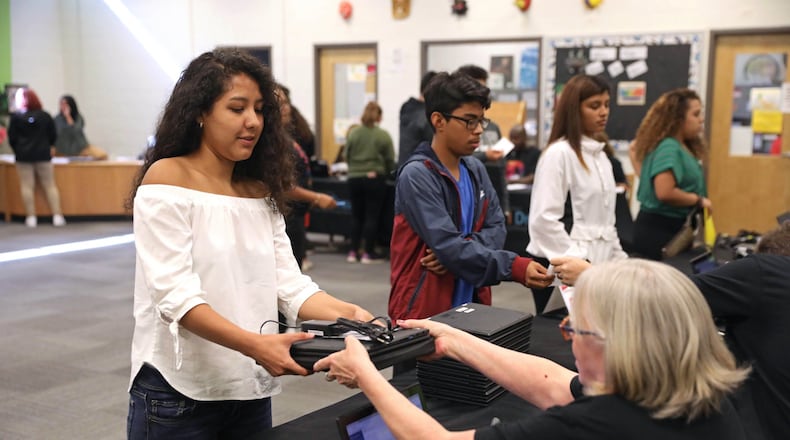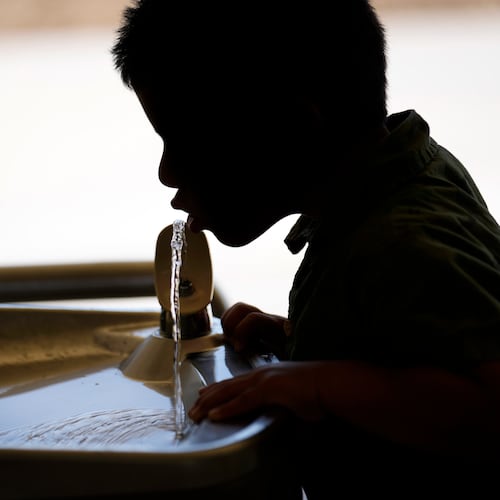When rain, wind, and then snow forced metro Atlanta school districts to close repeatedly last year, several systems told students to log into computers at home and keep up with classes digitally.
Atlanta Public Schools balked at the tech-driven approach to make up lost days. Leaders questioned whether it would be fair, since not all students have internet access and computers.
“Were we going to put people in a bad spot?” said Aleigha Henderson-Rosser, executive director for instructional technology. More than three quarters of APS students qualify for free or reduced-price meals, a crude marker of poverty.
Nationwide, estimates vary on the extent of the co-called “digital divide.” One report, from the U.S. Department of Education, found that 61 percent of children ages 3 to 18 had home internet access in 2015. In Georgia, about 10 percent of the population does not have access to fixed, high-speed internet, a problem particularly severe in rural areas, according to an FCC report.
Meanwhile, 14 percent of ACT test-takers surveyed said they had access to only one device at home. That's concerning, the college-entrance exam organization reported in August, because those students "may face challenges" other don't. They may have to share the device with siblings, limiting their ability to do homework, and don't have a backup if it breaks.
Across metro Atlanta, school districts have spent millions on technology and plan to invest more. As the digital push goes deeper — from textbooks to make-up snow days — experts and parents want to make sure students without home internet access or personal devices aren’t left behind.
"Digital equity has become the civil rights issue of our time," says a June report from the Consortium for School Networking, an association for school technology professionals.
Susan Bearden, the group’s chief innovation officer, said, “I think it’s easy for a lot of people who have maybe always had access to technology to assume that everybody has access to it.”
Area school districts have worked to bridge that gap in many ways. DeKalb and Fulton counties have been providing students with their own devices, a step Clayton County and Atlanta school districts also are pursuing.
DeKalb is wrapping up a roughly $27 million, sales tax-funded project that includes distributing laptops to all middle- and high-schoolers. When it finishes this month, the district will have handed out roughly 55,000 to students. It also has 25,000 wireless internet hot spots from Sprint available to let students connect online.
Before the project launched, about 30 percent of students lacked internet access, while 35 percent did not have a home computer, said DeKalb’s chief information officer Gary Brantley.
Cross Keys High School students lined up about a dozen deep to pick up a free hot spot on a recent school day. In the media center, DeKalb tech staffers passed out new laptops to students who paid a $20 fee for insurance.
Credit: Jason Getz
Credit: Jason Getz
“I know a lot of people who like didn’t really have any internet connection. Some people don’t even have phones or if they did have a laptop they would share with their siblings, which is kind of tough because assignments can be time-consuming,” said Joyce Korir, a 17-year-old Cross Keys senior.
She was one of those students without her own computer until this summer, when she bought a laptop after saving up money from her job at McDonald’s. She needs it for homework and as a member of the debate team.
Nathalie Baculima, 17, said her brother gave her a laptop as a birthday gift, but she scraped up the insurance money to get one the school issued, too.
“I kind of like actually struggled getting the $20 too, but I managed,” she said. “In this school …. we’re not as rich as you think we are.”
Most of Amanda Perdomo’s Cross Keys classmates without computers rely on cellphones for school work, but the senior said they’re difficult to use. Some websites don’t display properly on them.
“I know a lot of kids particularly in this school cannot afford a couple hundred dollars for a laptop, so I think for this situation it is very, very fair,” said Amanda, 17.
Equity has been “at the forefront” of the project’s planning, Brantley said: “If we did not, it would have caused a firestorm.”
Credit: Jason Getz
Credit: Jason Getz
Clayton County launched a pilot program in four schools this year to provide nearly 1,000 students with their own laptops. District officials hope to include roughly 38,0000 students in third through twelfth grades by 2022. The roughly $27.2 million project depends on voters agreeing in March to extend a sales-tax measure.
“We don’t want technology to be a barrier,” said Rod Smith, Clayton’s chief technology officer.
Fulton County Schools in December finished handing out 67,500 devices to sixth through twelfth graders as part of a $60 million project, paid for with sales tax.
When weather closures prompted the district's first "digital learning day" in March, Amy Barger, Fulton's assistant superintendent of learning and teaching, said the response "was overwhelmingly positive."
Fulton has digital textbooks for math, sciences, and in upper grades for world languages. Paper textbooks are also available. Barger said the district selects material that can be downloaded to be read later without an internet connection. Officials also pointed to low-cost programs that provide needy students with internet and said students can get online at community centers and libraries.
For at-home learning, some teachers plan lessons that don’t require online access, while others have taught live online lessons students could log in to.
APS plans to try out at-home learning this year, if needed because of weather closures, after distributing more devices and internet hot spots.
Last year, it launched a five-year, Sprint-backed program to distribute up to 25,000 devices and hot spots to needy high-schoolers. Another partnership, with $1.5 million from T-Mobile matched by $1.7 million from the district, will provide sixth- and seventh-grade students with gear by early November.
While APS uses digital resources in certain subjects, it’s shied away from relying completely on digital textbooks “until we get our access issues … at an equitable rate,” said Henderson-Rosser.
“It’s great stuff that’s out there. You want to harness that as quickly as possible, but you’ve got to step back and look at devices and access,” she said.
Not every district has made a priority of giving students a computer to take home. Gwinnett County, the state’s largest system with about 180,000 students, decided there wasn’t “a strong enough need for it for us to put that kind of funding behind it,” said Tricia Kennedy, executive director of instructional development and support.
She said good instruction doesn’t depend on devices.
“We certainly see technology as being a very important part of learning, but we also know that there’s a very valuable and valued place for print materials,” she said.
When nasty weather kept students out of school last year, the district turned to at-home learning days for the first time. Kennedy said she didn't hear from many students who lacked digital access, and schools offered students extra time to complete assignments if they couldn't do them at home.
Equity concerns popped up in Cobb County when schools began using digital textbooks.
Jennifer Maciejewski’s daughter attends Sprayberry High School, where this year she’s been assigned digital textbooks in two classes. Her daughter has had trouble viewing the material on her iPhone, and Maciejewski said the district has done a poor job of communicating to parents about the textbook changes.
She said the district has assumed wrongly that students have ready access at home.
Cobb officials repeatedly declined to answer questions about technology. The district issued a written statement saying that students have access to print resources at school and home along with the ability to use school computers.
But Maciejewski said that’s still not fair.
“The digital version of these textbooks is superior to a print copy,” she said, adding that all students should have the same access to resources. “Otherwise, we’re facilitating, and likely strengthening, the achievement gap between students living in economically disadvantaged situations and those that aren’t.”
About the Author
Keep Reading
The Latest
Featured




